2020年四川大学翻译硕士MTI考研真题及考研参考书
四川大学的翻译硕士考研好考吗?

四川大学的翻译硕士考研好考吗?各位考研的同学们,大家好!我是才思的一名学员,现在已经顺利的考上研究生,今天和大家分享一下这个专业的真题,方便大家准备考研,希望给大家一定的帮助。
我是川大研一的哈,考研时我旁边就坐一女的考川大翻译专业,360多,复试有所准备,考了专业的第三名,就业,还不就那样,反正整个川大在西南都还行,要是你想去沿海发展,你在学校就要自己多多努力了,毕竟内地的英语水平你也是知道了,好好考吧,没问题的。
望能帮到你翻译硕士高校排名第一批:1.北大招生30名,其中推免202.北外英语笔译60名(学制两年)(好像除了翻译基础和汉语百科,会考俄日法德其中一门二外)3.南开英语口笔译非在职和在职生各招收30名4.复旦英语笔译30名5.同济英语笔译德语笔译未列招生人数6.上海交大英语笔译未列招生人数7.上外英语笔译35人(下设法律翻译,公/商务笔译,专业编译三个方向)英语口译15人(下设会议口译方向,公/商务口译方向和陪同口译方向)法语口译5人8.南大英语笔译35人9.厦大英语口笔译各15人10.中南大学英语口笔译未列招生人数11.湖南师范英语口笔译未列招生人数12.中山英语笔译20人英语口译10人13.西南大学英语笔译未列招生人数14.广外英语笔译60人英语口译40人日语笔译20人日语口译10人法语口译10人其中英语翻译硕士复试参考书目991|翻译实务(笔译):1、《实用翻译教程(修订版)》,刘季春主编,中山大学出版社,2007年。
2、《英汉翻译基础教程》,冯庆华、穆雷主编,高等教育出版社,2008年。
3、《英语口译教程》,仲伟合主编,高等教育出版社,2007年。
4、《商务英语口译》(第二版),赵军峰主编,高等教育出版社,2009年。
5、有关英语八级考试的书籍,以及英美政治、经济、文化等方面百科知识的书籍992|面试(含口译):1、《实用翻译教程(修订版)》,刘季春主编,中山大学出版社,2007年。
四川大学英语语言文学专业和外国语言学及应用语言学专业硕士研究生入学考试科目及推荐参考书

四川大学英语语言文学专业和外国语言学及应用语言学专业硕士研究生入学考试科目及推荐参考书一、适用专业及方向:英语语言文学:现代英美文学、美国文化研究、加拿大文化研究、欧洲文化研究外国语言学及应用语言学:现代英语及语言理论、现代外语教育及教育技术、英语翻译理论与实践三、各科试题结构说明:1. 政治(国家统一考试,略)2. 二外(略)3. 基础英语 (150分):l Cloze Test或改错(10分)l 阅读理解(30分)l 英译汉(30分)l 汉译英(30分)l 阅读与写作(50分)4. 英语专业综合知识 (150分)l 英语国家社会和文化知识(50分)l 英语文学知识(50分)l 英语语言知识(50分)四、推荐参考书目(版本不限):基础英语、英语专业综合知识1. Beidler, Peter G. Writing Matters,四川大学出版社。
2. 郭著章,李庆生:《英汉互译实用教程》(第三版),武汉大学出版社。
3. 胡壮麟:《语言学教程》,北京大学出版社,2001年。
4. 李宜燮,常耀信:《美国文学选读》(上、下册),南开大学出版社。
5. 罗经国:《新编英国文学选读》(上、下册),北京大学出版社。
6. 王佐良等:《欧洲文化入门》(第二版)(第1-4章),外语教学与研究出版社。
7. 朱永涛: 《英美文化基础教程》,外语教学与研究出版社。
第二外语1.法语:《新大学法语》(1-3册),总主编李志清,高等教育出版社。
2.日语:《标准日本语》(初级),人民教育出版社。
3.德语:《德语速成》(第二版,上、下册),外语教学与研究出版社。
4.俄语:《大学俄语(东方)》(第1-3册),北京外国语大学、普希金俄语学院合编。
5.西班牙语:《现代西班牙语》(1-2册),董燕生.刘建.外研社。
6.韩语:延世大学韩国语学堂[韩] 编著:韩国语教程 1-3册(全6册),世界图书出版公司。
四川大学外国语学院英语语言文学专业和外国语言学及应用语言学专业硕士研究生入学考试复试科目及推荐参考书一、适用专业及方向:英语语言文学:现代英美文学、美国文化研究、加拿大文化研究、欧洲文化研究外国语言学及应用语言学:现代英语及语言理论、现代外语教育及教育技术、英语翻译理论与实践二、考试科目及分值:1. 听力(20分)测试要求:(a) 能听懂真实交际场合中各种英语会话和讲话;(b) 英语国家广播电台以及电视台(如CNN)有关政治、经济、文化、教育和科技等方面的专题报道以及与此类题材相关的演讲和演讲后的问答;(c) 能听懂有关政治、经济、历史、文化教育、语言文学和科普方面的一般讲座及讲座后的问答。
四川大学MTI口译经验及复习资料
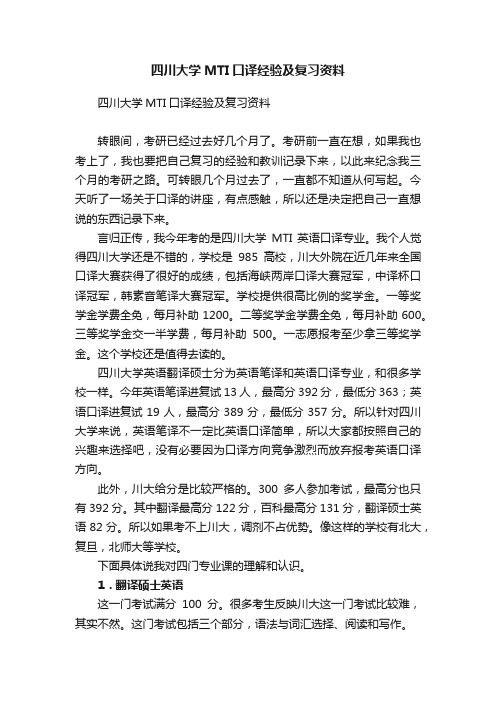
四川大学MTI口译经验及复习资料四川大学MTI口译经验及复习资料转眼间,考研已经过去好几个月了。
考研前一直在想,如果我也考上了,我也要把自己复习的经验和教训记录下来,以此来纪念我三个月的考研之路。
可转眼几个月过去了,一直都不知道从何写起。
今天听了一场关于口译的讲座,有点感触,所以还是决定把自己一直想说的东西记录下来。
言归正传,我今年考的是四川大学MTI英语口译专业。
我个人觉得四川大学还是不错的,学校是985高校,川大外院在近几年来全国口译大赛获得了很好的成绩,包括海峡两岸口译大赛冠军,中译杯口译冠军,韩素音笔译大赛冠军。
学校提供很高比例的奖学金。
一等奖学金学费全免,每月补助1200。
二等奖学金学费全免,每月补助600。
三等奖学金交一半学费,每月补助500。
一志愿报考至少拿三等奖学金。
这个学校还是值得去读的。
四川大学英语翻译硕士分为英语笔译和英语口译专业,和很多学校一样。
今年英语笔译进复试13人,最高分392分,最低分363;英语口译进复试19人,最高分389分,最低分357分。
所以针对四川大学来说,英语笔译不一定比英语口译简单,所以大家都按照自己的兴趣来选择吧,没有必要因为口译方向竞争激烈而放弃报考英语口译方向。
此外,川大给分是比较严格的。
300多人参加考试,最高分也只有392分。
其中翻译最高分122分,百科最高分131分,翻译硕士英语82分。
所以如果考不上川大,调剂不占优势。
像这样的学校有北大,复旦,北师大等学校。
下面具体说我对四门专业课的理解和认识。
1.翻译硕士英语这一门考试满分100分。
很多考生反映川大这一门考试比较难,其实不然。
这门考试包括三个部分,语法与词汇选择、阅读和写作。
语法多是英语专业四级(TEM4)语法选择题的'难度,考点多是虚拟语气,定语从句,名词性从句,只要把历年的专四真题和模拟题弄明白,就基本都能做对。
词汇选择也类似于专四的词汇辨析题,四个选项都是近义词,比较难区分。
川大mti考研真题

川大mti考研真题考研是许多学子们追求更高学业水平的重要途径之一,而川大MTI (Master of Translation and Interpreting)作为翻译和口译专业的硕士研究生课程,备受学生们的关注。
本文将介绍川大MTI考研的相关内容,包括考试科目、考试形式以及备考方法等。
一、考试科目川大MTI考研科目主要包括文学类和语言学类两个方向。
文学类包括外国文学、中国文学、外国语言文学等,语言学类包括语言学、语言教学学、应用语言学等。
考生可以根据自己的兴趣和专长选择相应的方向并进行复习。
二、考试形式川大MTI考研的考试形式包括笔试和口试两个部分。
笔试主要考察考生的语言运用能力和专业知识,题型包括选择题、填空题、翻译题等。
口试主要考察考生的口头表达能力和听力理解能力,题型包括口语考试和听力考试。
三、备考方法1. 提前规划:提前规划是川大MTI考研备考的关键。
考生应该提前了解考纲、考试科目以及考试难度,制定合理的备考计划。
2. 多练习:川大MTI考研注重考察语言运用能力,因此考生需要大量练习,并注意积累词汇和短语。
可以通过刷题、做模拟试卷等方式来提高自己的应试能力。
3. 提高听力水平:川大MTI考研口试部分包括听力考试,因此考生需要通过听英语新闻、听力练习等方式来提高听力水平。
4. 注意阅读:考生在备考过程中要注重阅读相关的学术文献、翻译参考书籍等,提高自己的阅读理解和翻译能力。
5. 制定复习计划:备考期间,考生应制定详细的复习计划,合理安排每天的学习时间。
可以根据自己的时间安排,将不同的科目分配到不同的时间段,提高复习的效率。
4. 寻求帮助:备考过程中遇到难题或不懂的知识点可以向老师、同学、研究生导师等寻求帮助。
多和他人交流讨论能够拓宽自己的思路。
总之,川大MTI考研是需要认真备考和努力提高语言能力的过程。
通过科学的备考方法和坚持不懈的努力,相信你一定可以取得优异的成绩。
祝愿考生们在考研中取得好的成绩,并实现自己的学业目标!。
四川大学外国语学院MTI翻译硕士357英语翻译基础448汉语写作与百科知识考
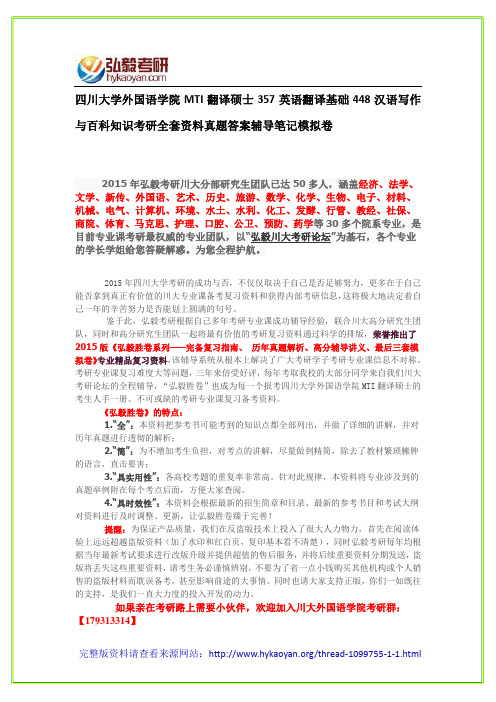
四川大学外国语学院MTI翻译硕士357英语翻译基础448汉语写作与百科知识考研全套资料真题答案辅导笔记模拟卷2015年弘毅考研川大分部研究生团队已达50多人,涵盖经济、法学、文学、新传、外国语、艺术、历史、旅游、数学、化学、生物、电子、材料、机械、电气、计算机、环境、水土、水利、化工、发酵、行管、教经、社保、商院、体育、马克思、护理、口腔、公卫、预防、药学等30多个院系专业,是目前专业课考研最权威的专业团队,以“弘毅川大考研论坛”为基石,各个专业的学长学姐给您答疑解惑。
为您全程护航。
2015年四川大学考研的成功与否,不仅仅取决于自己是否足够努力,更多在于自己能否拿到真正有价值的川大专业课备考复习资料和获得内部考研信息,这将极大地决定着自己一年的辛苦努力是否能划上圆满的句号。
鉴于此,弘毅考研根据自己多年考研专业课成功辅导经验,联合川大高分研究生团队,同时和高分研究生团队一起将最有价值的考研复习资料通过科学的排版,荣誉推出了2015版《弘毅胜卷系列——完备复习指南、历年真题解析、高分辅导讲义、最后三套模拟卷》专业精品复习资料,该辅导系统从根本上解决了广大考研学子考研专业课信息不对称、考研专业课复习难度大等问题,三年来倍受好评,每年考取我校的大部分同学来自我们川大考研论坛的全程辅导,“弘毅胜卷”也成为每一个报考四川大学外国语学院MTI翻译硕士的考生人手一册、不可或缺的考研专业课复习备考资料。
《弘毅胜卷》的特点:1.“全”:本资料把参考书可能考到的知识点都全部列出,并做了详细的讲解,并对历年真题进行透彻的解析;2.“简”:为不增加考生负担,对考点的讲解,尽量做到精简,除去了教材繁琐臃肿的语言,直击要害;3.“具实用性”:各高校考题的重复率非常高。
针对此规律,本资料将专业涉及到的真题举例附在每个考点后面,方便大家查阅。
4.“具时效性”:本资料会根据最新的招生简章和目录、最新的参考书目和考试大纲对资料进行及时调整、更新,让弘毅胜卷臻于完善!提醒:为保证产品质量,我们在反盗版技术上投入了很大人力物力,首先在阅读体验上远远超越盗版资料(加了水印和红白页,复印基本看不清楚),同时弘毅考研每年均根据当年最新考试要求进行改版升级并提供超值的售后服务,并将后续重要资料分期发送,盗版将丢失这些重要资料,请考生务必谨慎辨别,不要为了省一点小钱购买其他机构或个人销售的盗版材料而耽误备考,甚至影响前途的大事情。
川大MTI样题 参考答案

国内近年出版的用英语编写的高级英语阅读、翻译、写作教材,以及任何大学语文教材和应用文写作类书籍(汉语)。
《汉语写作与百科知识》样题第一部分百科知识(50’)请简要解释以下段落中划线部分的知识点1.这次股市波动在全球都有一定的关联影响,这说明全球化在逐步进展。
过去中国认为自己的市场是一个相对比较小型的市场,也是一个正在建设中的、比较幼年的市场,或者说是在转轨经济中逐步发展的新兴市场。
由于全球经济一体化的进展,股市波动相互之间关联密切,这也说明中国的市场还需要加速发展,我们要进一步提高直接融资的比重,进一步把资本市场建设得更好、更快、更加国际化。
关于流动性过剩问题。
流动性偏多是全球的现象,中国也存在流动性偏多的问题。
美国财政赤字那么大,它那儿的流动性也很丰富,产油国资金也很丰富。
因此,资金面上的宽松是全球一体化之下相互影响的现象。
宏观调控当局都应该重视这个问题,做好自己的工作,对于过剩的流动性应该采取稳健的、适当收缩的政策。
2.端午原是个防病防灾的日子,却因大诗人屈原增添了纪念层面的意义,增添了爱国情怀和报国无门的悲情、齐心协力救助生命的悲壮;因了陶渊明酷爱重阳,因了他酷爱的菊的勾连,重阳节衍生了“颂陶”的文化意蕴,歌颂他“人淡如菊”的精神境界,“重阳无酒”也成了知识分子安贫乐道的形象写真。
3.1994年起,比尔·盖茨开始了他的收藏爱好。
作为拥有600亿美元财富的收藏者,盖茨想买什么就可以买什么,而他购买艺术品似乎也完全凭个人的兴趣,没有明确的学术或商业性目标。
还有很多不知名的微软富翁也有收藏艺术品的爱好,这些微软人囊中的巨额财富和近乎疯狂的收藏行为对美国艺术市场产生巨大的推动作用,证明了微软公司在文化市场中有多重要。
一个软件公司创造的巨额财富使大量重要艺术作品流向微软人手中,流向西雅图。
4.2009年3月的全国“两会”上,吴邦国提出,今年要着力加强社会领域立法,继续完善经济、政治、文化领域立法。
四川大学翻译硕士考研真题及答案
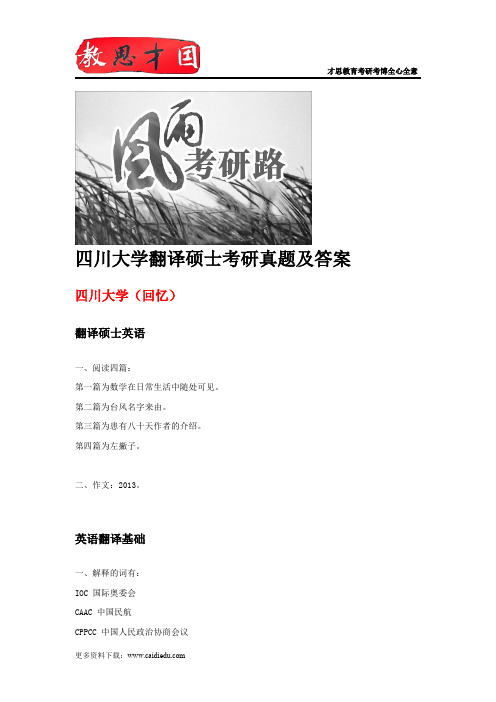
四川大学翻译硕士考研真题及答案四川大学(回忆)翻译硕士英语一、阅读四篇:第一篇为数学在日常生活中随处可见。
第二篇为台风名字来由。
第三篇为患有八十天作者的介绍。
第四篇为左撇子。
二、作文:2013。
英语翻译基础一、解释的词有:IOC国际奥委会CAAC中国民航CPPCC中国人民政治协商会议NBA美国职业篮球联赛UNEP联合国环境规划署FBI美国联邦调查局Federal Bureau of Investigationpurchasing power parity购买力平价"三农"工作work relating agriculture,rural areas and farmers伪娘cross dresser大规模杀伤性武器weapons of mass destruction易经book of changes京都议定书Kyoto Protocol经济适用房economically affordable housing中国达人秀China's Got TalentIOC、CAAC、CPPCC、NBA、UNEP、FBI、purchasing power parity、"三农"工作、伪娘、大规模杀伤性武器、易经、京都议定书、经济适用房、中国达人秀、African Union、Fannie Mae&Freddie Mac、MDGs、亚运会、可再生资源、第十一届全国人民代表大会第三次会议二、英翻汉:一篇是动物实验,一篇是归纳问题。
三、汉翻译:一篇是西部论坛的讲话,一篇是新闻网络。
汉语写作与百科知识一、新青年、新文化运动、胡适、狂人日记、欧洲文艺复兴、工业革命、但丁、米开朗基罗、存款准备金利率、贸易顺差、外商直接投资、宏观调控、上海世博会、知识产权、民商法二、应用文:索赔函三、作文:混乱的价值。
四川大学外国语学院攻读硕士学位研究生入学考试参考样题

Part One I.
European and American Cultures (50 points)
Explain any THREE out of the following five terms IN ABOUT 50 WORDS each: (15 points) William the Conqueror Homer The War of Roses Martin Luther The melting pot
1. 2. 3. 4. 5.
II. Fill in the blanks in the following to complete the idea: (10 points) 1. The full name of the United Kingdom is _____________________ . 2. Thanksgiving Day falls on _______, on which Americans give thanks for _ _____; the _. executive
5. The Bible is a collection of religious writings comprising two parts: the __________________ and the__________________. 6. The word “Renaissance” means _______________, it generally refers to the period in
本题共 5 页,此页为第 1 页
四川大学外国语学院攻读硕士学位研究生入学考试参考样题---英语专业综合知识
Western civilization between the ____________ and mid _______________century. 7. In the early 1930s, ___________________ brought poverty and humiliation to millions of people in the United States and Europe. 8. 9. The American War of Independence began in _____________ and ended in _________. The United States government form is based on the three main principles: Federalism, ___________________________________and ________________________________. 10. Henrik Ibsen was born in ________________, as the Father of Modern Drama he was famous for his “ __________ plays.”
2020-2021四川大学英语翻译硕士考研择校、报录比、考研经验分享
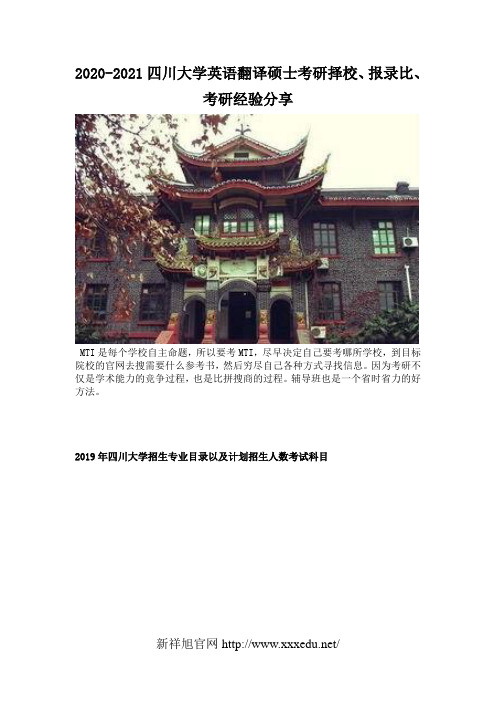
2020-2021四川大学英语翻译硕士考研择校、报录比、考研经验分享MTI是每个学校自主命题,所以要考MTI,尽早决定自己要考哪所学校,到目标院校的官网去搜需要什么参考书,然后穷尽自己各种方式寻找信息。
因为考研不仅是学术能力的竞争过程,也是比拼搜商的过程。
辅导班也是一个省时省力的好方法。
2019年四川大学招生专业目录以及计划招生人数考试科目参考书目1、211翻译硕士英语《高级英语》(修订本)第1、2册(重排版),王立礼、张汉熙,外语教学与研究出版社,2010年。
2、357英语翻译基础(1)《英汉翻译简明教程》,庄绎传,外语教学与研究出版社,2002年;(2)《英汉口译教程》,任文,外语教学与研究出版社,2011年;(3)《非文学翻译理论与实践》,李长栓,中国对外翻译出版公司,2012年;(4)《英语笔译实务》,卢敏,外文出版社,2017年;国内主要英文报刊。
3、448汉语写作与百科知识(1)《中国文化读本》(中文版) 叶朗,外语教学与研究出版社,2008年;(2)《中国文化概要》,陶嘉炜、何寅,北京大学出版社,2009年;(3)《英语国家社会与文化》,梅仁毅,外语教学与研究出版社,2008年;(4)《应用文写作》,王首程,高等教育出版社,2009年。
注:以上参考书目非学校指定,是根据以往经验给出的,仅供参考。
历年数据分析2018年川大英语翻译硕士初试经验分享英语翻译基础如何准备?背!单!词!!这是最基础也是最重要的。
背单词这个过程贯穿了我考研整个过程,当单词量真的上升到一定程度,你会发现自己英语像开挂了一样。
专八词汇,《李毅10000》,一定要一个一个,一遍又一遍好好背。
背了一遍记不住没关系,再来一遍,强烈推荐《英语文摘》这个杂志,它全是精选的外刊文章,翻译地道,而且有难点词语解释,是学习英语很好的材料。
这是新祥旭给我辅导的老师建议的。
建议每两天读一篇,一定要准备一个笔记本,把自己认为写得好的表达总结下来,不会的单词也摘抄下来,每天记,每天背单词。
2020年四川外语学院翻译硕士考研参考书及考研笔记

2020年四川外语学院翻译硕士考研参考书及考研笔记参考书:1.《实用翻译教程(修订版)》,刘季春,中山大学出版社,20072.《英汉翻译基础教程》,冯庆华、穆雷,高等教育出版社,20083.《英语口译教程》,仲伟合,高等教育出版社,20074.《商务英语口译》(第二版),赵军峰,高等教育出版社,20095.《汉语写作与百科知识》,李国正,首都师范大学出版社,20196.有关英语八级考试的书籍,以及英美政治、经济、文化等方面百科知识的书籍。
7.《翻译硕士MTI常考词汇》,李国正,首都师范大学出版社,2020总体要求:报录比:1:6笔译98人,口译52人。
复试科目:英汉互译。
同力加试:1英语综合;2高级写作。
育明教育咨询师认为四川外国语学院翻译硕士报考难度中等偏低,适合跨专业报考。
答题技巧:论述题(1)名师解析论述题在考研专业课中属于中等偏上难度的题目,考察对学科整体的把握和对知识点的灵活运用,进而运用理论知识来解决现实的问题。
但是,如果我们能够洞悉论述题的本质,其实回答起来还是非常简单的。
论述题,从本质上看,是考察队多个知识点的综合运用能力。
因此,这就要求我们必须对课本的整体框架和参考书的作者的写书的内部逻辑。
这一点是我们育明考研专业课讲授的重点,特别是对于跨专业的考生来说,要做到这一点,难度非常大。
(2)答题攻略:论述题三步走答题法是什么——〉为什么——〉怎么样第一,论述题中重要的核心概念,要阐释清楚;论述题中重要的理论要点要罗列到位。
这些是可以在书本上直接找到的,是得分点,也是进一步分析的理论基点。
第二,要分析目前所存在问题出现的原因。
这个部分,基本可以通过对课本中所涉及的问题进行总结而成。
第三,提出自己合理化的建议。
(3)温馨提示第一,回答的视角要广,不要拘泥于一两个点。
第二,在回答论述题的时候一定要有条理性,但是条数不宜过多,字数在1500左右。
用时为25-30分钟。
如果试卷中有3道(一般不会更多)论述题,你可以答800-1000字,如果有两道,你可以答1000-1200字左右。
四川大学翻译硕士英语考试样题

翻译硕士英语考试科目:211翻译硕士英语适用专业:英语口译(MTI)、英语笔译(MTI)(试题共14页)(注意:答案必须写在答题纸上,写在试题上不给分)I. Vocabulary and grammar (30’)Multiple choiceDirections: Beneath each sentence there are four words or phrases marked A, B, C and D. Choose the answer that best completes the sentence. Mark your answers on your answer sheet.1. The forests were very dry because of the dry spell.A. tree lineB. explorersC. draftD. drought2. Self-denial is one of their tenets.A. reasonsB. doctrinesC. rentersD. figures3. The Iranians did not see eye to eye with the Americans about releasing the hostages.A. viewB. scareC. agreeD. quarrel4. The most pressing problem any economic system faces is how to use its scarce resources.A. puzzlingB. difficultC. terrifyingD. urgent5. The firm of Bonnin and Morris in Philadelphia was probably the first American company to manufacture porcelain.A. silverwareB. crystalC. chinaD. linen6. Children who come from deprived families are frequently poor readers.A. without respectB. without experienceC. without fundsD. without legs7. They raised a hue and cry just outside the gate.A. surrenderedB. built a temporary shelterC. made a great deal of noiseD. flew the flag8. Carlo showed us his diagram if the machine.A. insidesB. screwsC. sketchD. masterpiece9. The beggar solicited passers-by for money.A. requestedB. scowled atC. bargained withD. chased10. He took on so much work, he had no time for pleasure.A. allowedB. increasedC. accomplishedD. assumed11. Essentially, a theory is an abstract, symbolic representation of _________realityA. what it is conceivedB. that is conceivedC. what is conceived to beD. that is being conceived of12. Using many symbols makes _______ to put a large amount of information on a single map.A. possibleB. it is possibleC. it possibleD. that possible13. A vacuum tube is a glass tube from which most of the air has been removed, _______ an almost complete vacuum.A. creatingB. createsC. is creatingD. it creates14. Booker T. Washington, acclaimed as a leading educator at the turn of the century, _____ of a school that later became the Tuskegee Institute.A. took chargeB. taking chargeC. charge was takenD. taken charge15. True hibernation takes place only among _______ animals.A. whose blood is warmB. blood warmC. warm-bloodedD. they have warm blood16. In central Georgia, archaeological evidence indicates that Native Americans first inhabited the area________.A. since thirteen centuriesB. thirteen centuries agoC. the previous thirteen centuriesD. thirteen centuries were before17. In ________, the advent of the telephone, radio, and television has made rapid long-distance communication possible.A. one hundred years laterB. one hundred years agoC. the one hundred years sinceD. the last one hundred years18. ________, The Yearling, won a Pulitzer Prize.A. Marjorie Rawlings’best work wasB. Marjorie Rawlings’best workC. Her best work was Marjorie Rawlings’D. That Marjorie Rawlings’best work19. Abstraction goes into the making of any work of art, ________ or not.A. whether the artist being aware of itB. the artist is being aware whetherC. whether the artist is aware of itD. the artist is aware whether20. Not until 1931 ________ the official anthem of the United StatesA. “The Star-spangled Banner”did becomeB. when “The Star-spangled Banner”becameC. did “The Star-Spangle Banner”becomeD. became “The Star-spangled Banner”II. Reading comprehension (40’)Section 1 Multiple choice (20’)Directions: In this section there are reading passages followed by multiple-choice questions. Read the passages and then mark your answers on your answer sheet.Passage AJustice and injustice in criminal adjudication are more than abstract concept; in modern America each term conjures up its own paradigm image. Justice occurs in a somber courtroom where a robber reaches a legal decision. Injustice is a bloodthirsty mob bearing lit torches, intimidating on the doors of the jail desperate to wreak revenge upon the suspected wrongdoer held within.This image of injustice provides many normative insights. One that courts have frequently drawn is that in criminal adjudication emotion is unalterably opposed to reason and thus to justice itself. Taking this principle a step farther, courts have urged that the more a legal issue might provoke popular rage, the harder courts must work to insulate the legal decision from emotive influence. The classic example is capital sentencing, an occasion which evokes strong emotions. Here the Supreme Court has worked to ensure that “any decision to impose the death sentence be, and appear to be, based on reason rather than caprice or emotion”. The Court has, over a period of years, undertaken an extensive regulatory project aimed at suppressing emotive influence in capital cases by mandating rationalistic ruled to guide sentencing. This insistence upon the injustice of all emotion stems from a misconception of emotion and its influence upon criminal punishment. Although the mob at jail scene illustrates that anger can lead to injustice, it does not support the proposition that all decisions influenced by anger are morally tainted. Anger can be justified and have moral decision making is complex; untangling it involved a close examination of emotion than the law has generally undertaken.This has obvious significance for criminal law as a form of social concord. But it is also important or its alleged role as a restraint on power. Criminal law does little or nothing to restrict the efforts of the various professionals now responsible for preventing and reshaping deviant behavior. Rather it is them who have colonized its territory, as in the welfare of the professional authority that legitimates them and because they enter into the enabling role of the state as dispenser of benefits. This is to say nothing of other forms of market and bureaucratic power and social control exercised by groups other than government. Under these conditions the alleged protections of the criminal law seem premised on a nineteenth century view of the state and society; those interested in the law in the twentieth century must look to the potential of administrative law rather than to criminal law. Either way critical writers would be wasting their time here.Whilst there is a lot of truth in this picture of the declining importance of criminal law, it issensible not to exaggerate its loss of functions. From a critical point of view it would seem to retain a crucial ideological significance as being the form of closet touch with public. It is hard to credit the idea that these central liberal (bourgeois) notions have been displaced by the newer disciplines and strategies.1.The reason for the insulation of emotions in criminal adjudication is due to_______.A. the severity of the possible punishmentB. the social concern for the adjudicationC. the Supreme Court decisionD. the ideal of keeping order2. According to the author’s opinion, the origination of the insistence upon the injustice of all emotion is __________.A. that emotion is inevitably against reason and justiceB. the misunderstanding of emotion and its influenceC. the courts’hard work to prevent the legal decision from emotive influenceD. that the death sentence was based on reason through suppressing emotive influence3. Regards to the role of anger in adjudication, which statement is INCORRECT?A. Only part of the decisions is influenced by anger, though it can bring biases.B. Though moral decision-making is complex, anger can be justifiedC. Some decisions influenced by anger can be morally taintedD. Because of anger, moral decision-making is quite complicated4. The declining importance of criminal law is a consequence of ___________.A. the loss of importance of criminal law and increase of interest in government as a benefit dispenserB. the exaggeration of the importance of criminal law and decrease of interest in government affairsC. the new trend in legal studiesD. the new ideas pouring out in the administrative law field5. The review is primarily ___________.A. dubiousB. objectiveC. partialD. criticalPassage BThe Eskimos believe that a human being is made up of a body, a soul, and a name, and it not complete unless it has all three. This belief has a great effect on the Eskimo’s daily life and runs like a golden thread through the Eskimo culture.As for the soul of man, the Eskimos do not claim to know exactly what it is—but then, who does? They see it, however, as the beginning of life, the initiator of all activities within a being, and the energy without which life cannot continue.An Eskimo’s name is believed to have a life of its own. It combines all the good qualities and talents of all the persons who have been called by it. One may imagine it as a procession ofancestors stretching into the dim past and surrounding the present bearer of the name with a sort of magic protective aura.Many Eskimos believe that a newborn baby cries because it wants its name and will not be complete until it gets it. Immediately after a birth the angakok (medicine man) or some wise elders of the tribe gather to name the child. The name that is selected must be the name of someone who has died recently. The choice may in some cases call for much conjuring and soothsaying, and in other cases be self-evident. When my son was born, everyone realized that it was his great-grandfather, Mequsaq, who had died a few months before, who had been reborn in him. The newborn infant had a slight squint in the very same eye that old Mequsaq had lost to the cannibals in Baffin Land. This was taken as a sign from the name spirit that the baby should be called Mequsaq.When, in 1927, I returned to Thule for a visit, I found that no fewer than five little girls had been named Navarana after my dear late wife. So great was the confidence in Navarana’s ability and character that there was believed to be enough for all five children. It was thus a beautiful and touching memorial to her, though a slightly expensive one for me, since I had to give all the little girls presents.More often he newborn child was given several names, so as to have the highest possible protection, and certain names became great favorites. Calling so many by the same name was often very confusing. This custom was continued in Christianized Greenland. In the little settlement of Kook, in the Upernavik district, all five hunters were called Gaba (after the archangel Gabriel). I was told that some years before, a great man called Gaba had died, and after his death several unmistakable signs indicated that his spirit was still active. To please the spirit, many boy babies were named after it. In order to distinguish between them they called them “fat Gaba,”“Little Gaba,”etc.A Polar Eskimo would never mention himself by name. Doing so could break the name’s magic protection. And since the ever jealous spirits are always listening, it could cause great trouble. It seemed strange to me in the beginning, when I met somebody in the dark of winter, that I was never able to get any information other than “Oanga”(it is I). Finally I learned to know them all by their voices.The Eskimo people believe also in the magic protective power of amulets, However, it isn’t the amulet itself that protects from harm—it is the properties that the amulet possesses. It is almost always the boys and the men who are given amulets, for they are the ones who expose themselves to all the dangers of nature while the women stay at home. When a girl is given amulets, it is usually to insure that she have strong sons. Great care goes into the selection of amulets. My wife Navarana carried a little ball of polished wood with her always. Wood cannot feel pain, and possession of it means great wealth; thus it is thought that a wooden amulet can insure the owner a rich and painless life.One of the most popular amulets is the foot of a raven, which is put on a string around the necks of newborn babies. This is believed to be a very valuable charm because no bird can get along under as hard conditions as does the raven. The raven finds food where other animals starve to death—it can live on almost nothing.At the end of my first walrus hunt at Thule, Ayorsalik, one of the hunters, decided that raven meat was to be eaten in my honor. The purpose of the raven feast, he said, was to make sure that the good luck I had had that morning would continue indefinitely.Two of the younger men shot three ravens that had been hovering expectantly near our campfire. Ayorsalik out the pot on to boil, and the ravens were skinned and cooked.Their taste was revolting, and later I ate that bird only in times of great hunger. On this occasion Ayorsalik handed me all three hearts and livers with his fingers; they went down, but they almost came up again. I don’t know whether this ritual had any effect. But later on, whenever I had sizable game, Ayorsalik claimed I would lose the ravens’power if I were not to share with him.Another interesting custom of the Eskimos is their ceremony of reverence for ancestors. On the rock of Agpat, near Thule, where the burial ground was, both men and women would sit for hour after hour in quiet meditation. Dressed in their finest clothing, they would stare out over the horizon without moving. They believed that during this stillness they received the wisdomof their ancestors. It is the nearest thing to religious devotion I have seen among them, and it is, I think, the most beautiful form of worship I have ever seen.To the Eskimo, nature is full of evil spirits ready to work ill if a sin or breach of taboo is committed. When a tribe is afflicted with sickness or bad weather or starvation, it is up to the angakok to find out how the people, knowingly or unknowingly, have offended the spirits. He can summon his helping spirits, he can travel to the underworld, under the sea, and through rocks, and thus find out where the trouble is.Essentially, angakoks are people who are experienced in the state of trance. I have often observed even the people serving in our house at Thule in a state of trance, sometimes for days on end. To understand the Eskimos, it is necessary to remember the long depressing winter with its black darkness and its aura of lurking evil, and the summer with its perpetual sunshine that wearies the mind and confuses the senses. Every fall we had a veritable epidemic of evil spirits along with the storms and the darkness of winter setting in. There was always panic at this time.The Eskimos know no benevolent god. They believe that the spirits of the angakoks and the protective spells of names and amulets are their only defense against a cold and hostile land.6. If asked “Who is it?”an Eskimo would answer only “It is I,”because______.[A] he would not want anyone to know who he was[B] if he said his own name he would break its spell[C] he did not know his actual name[D] Both A and B.7. There is evidence in the passage that the author’s wife had______.[A] won the Eskimos’approval during several visits[B] many names[C] been accepted by the Eskimos only because of their love for her husband.[D] been an Eskimo herself8. According to the passage, Eskimos depend most heavily on______.[A] evil spirits[B] charms and magic[C] a helpful god[D] nature9. The word “revolting”in paragraph 12 means______.[A] shocking[B] rebellious[C] nauseating[D] wicked10. The Eskimo believed that sitting quietly near their buried ancestors_______.[A] was the best way to express faith in God[B] helped the hunters to find food[C] gave them the wisdom of their ancestors[D] was the best way to pay tribute to the dead.Section 2 Answering questions (20’)Directions: Read the following passages and then answer IN COMPLETE SENTENCES the questions which follow each passage. Use only information from the passage you have just read and write your answer in the corresponding space in your answer sheet.Questions 1~3What do we mean by leisure, and why should we assume that it represents a problem to be solved by the arts? The great ages of art were not conspicuous for their leisure-at least, art was not an activity associated with leisure. It was a craft like any other, concerned with the making of necessary things. Leisure, in the present meaning of the word, did not exist. Leisure, before the Industrial Revolution meant no more than “time”or “opportunity”; “If your leisure serv'd, I would speak with you”, says one of Shakespeare's characters. Phrases which we still use, such as “at your leisure”, preserve this original meaning.But when we speak of leisure nowadays, we are not thinking of securing time or opportunity to do something; time is heavy on our hands, and the problem is how to fill it. Leisure no longer signifies a space with some difficulty secured against the pressure of events: rather it is a pervasive emptiness for which we must invent occupations-Leisure is a vacuum, a desperate state of vacancy--a vacancy of mind and body. It has been commandeered by the sociologists and the psychologists: it is a problem.Our diurnal existence is divided into two phases, as distinct as day and night. We callthem work and play. We work so many hours a day, and, when we have allowed the necessary minimum for such activities as eating and shopping, the rest we spend in various activities which are known as recreations, an elegant word which disguises the fact that we usually do not even play in our hours of leisure, but spend them in various forms of passive entertainment or entertainment--not football but watching football matches; not acting, but theatre-going; not walking, but riding in a motor coach.We need to make, therefore, a hard-and-fast distinction not only between work and play but, equally, between active play and passive entertainment. It is, I suppose, the decline of active play —of amateur sport—and the enormous growth of purely receptive entertainment which has given rise to a sociological interest in the problem. If the greater part of the popu1ation, instead of indulging in sport, spend their hours of leisure ‘viewing' television programmes, there will inevitably be a decline in health and physique. And, in addition, there will be a psychologicalproblem, for we have yet to trace the mental and moral consequences of a prolonged diet of sentimental or sensational spectacles on the screen. There is, if we are optimistic, the possibility that the diet is too thin and unnourishing to have much permanent effect on anybody. Nine films out of ten seem to leave absolutely no impression on the mind or imagination of those who see them: few people can give a coherent account of the film they saw the week before last, and at longer intervals they must rely on the management to see that they do not sit through the same film twice.We have to live art if we would be affected by art. We have to paint rather than look at paintings, to play instruments rather than go to concerts, to dance and sing and act ourselves, engaging all our senses in the ritual and discipline of the arts. Then something may begin to happen to us: to work upon our bodies and our souls.It is only when entertainment is active, participated in, practiced, that it can properly be called play, and as such it is a natural use of leisure. In that sense play stands in contrast to work, and is usually regarded as an activity that alternates with work. It is there that the most fundamental error enters conception of daily life.Work itself is not a single concept. We say quite generally that we work in order to make a living: to earn, that is to say, sufficient tokens which we can exchange for food and shelter and all the other needs of our existence. But some of us work physically, tilling the land, minding the machines, digging the coal; others work mentally, keeping accounts, inventing machines, teaching and preaching, managing and governing. There does not seem to be any factor common to all these diverse occupations, except that they consume our time, and leave us little leisure.We may next observe that one man's profession or work is often another man’s recreation or play. The merchant at the week-end becomes a hunter (he has not yet taken to mining); the clerk becomes a gardener; the machine-tender becomes a breeder of bull—terriers. There is, of course, a sound instinct behind such transformations. The body and mind are unconsciously seeking compensation--muscular coordination, mental integration. But in many cases a dissociation is set up and the individual leads a double life--one half Jekyll, the other half Hyde. There is a profound moral behind that story of Stevenson's for the compensation which a disintegrated personality may seek will often be of an anti-social nature. The Nazi party, for example, in its early days was largely recruited from the bored--not much from the unemployed as from the street-corner society of listless hooligansScientific studies have been made of street-corner society, out of which crime, gangsterdom, and fascism inevitably develop. It is a society with leisure--that is to say, spare time--and without compensatory occupation. It does not need a Satan to find mischief for such idle hands to do. They will spontaneously itch to do something: muscles have a life of their own unless they are trained to purposeful actions. Actions, or rather activities, are the obvious reflex to leisure; they consume it, and leave the problem solved.But work is also activity, and if we reach the conclusion that all our time must be filled with one activity or another, the distinction between work and play becomes rather meaningless, and what we mean by play is merely a change of occupation. We pass from one form of activity to another; one we call work, and for that we receive pay; the other we call play, and for that we receive no pay--on the contrary, we probably pay a subscription.1. The author points out two kinds of danger that may arise from the misuse of leisure. One of them is the result of purely passive entertainment; the other results when work and play are not properly coordinated What are the two dangers? Which of them is particularly harmful to society?2. The author says that most films are not good enough to leave a permanent impression on our minds. Is this, in his opinion, a good thing or a bad thing? In what way?3. What, in the author’s opinion, is the real difference between work and play? Or is there no difference at all between them? .Questions 4~5History tells us that in ancient Babylon, the cradle of our civilization, the people tried to build a tower that would reach to heaven. But the tower became the tower of Babel, according to the Old Testament, when the people were suddenly caused to speak different languages. In modern New York City, a new tower, that of the United Nations Building, thrusts its shining mass skyward. But the realization of the UN’s aspirations—and with it the hopes of the peoples of the world—is threatened by our contemporary Babel: about three thousand different languages are spoken throughout the world today, without counting the various dialects that confound communication between peoples of the same land.In China, for example, hundreds of different dialects are spoken; people of some villages have trouble passing the time of day with the inhabitants of the next town. In the new African state of Ghana, five million people speak fifty different dialects. In India more than one hundred languages are spoken, of which only fourteen are recognized as official. To add to the confusion, as the old established empires are broken up and new states are formed, new official tongues spring up at an increasing rate.In a world made smaller by jet travel, man is still isolated from many of his neighbors by the Babel barrier of multiplying languages. Communication is blocked daily in scores of ways. Travelers find it difficult to know the peoples of other nations. Scientists are often unable to read and benefit from the work being carried on by men of science in other countries. The aims of international trade, of world accord, of meetings between nations, are blocked at every turn; the work of scholars, technologists, and humanists is handicapped. Even in the shining new tower of the United Nations in New York, speeches and discussions have to be translated and printed in the five official UN languages—English, French, Spanish, Russian and Chinese. Confusion, delay, suspicion, and hard feelings are the products of the diplomatic Babel.The chances for world unity are lessened if in the literal sense of the phrase, we do not speak the same language. We stand in dire need of a common tongue a language that would cross national barriers, one simple enough to be universally learned by travelers, businessmen, government representatives, scholars, and even by children in school.Of course, this isn’t a new idea. Just as everyone is against sin, so everyone is for a common language that would further communication between nations. What with one thing and another —our natural state of drift as human beings, our rivalries, resentments, and jealousies as nations —we have up until now failed to take any action. I propose that we stop just talking about it, as Mark Twain said of the weather, and do something about it. We must make the concerted, massive effort it takes to reach agreement on the adoption of a single, common auxiliary tongue. Let’s take a quick look at the realities of the problem. One of the main barriers to the adoption of the common language is the fact that there is Babel even among the possible languages we canchoose. A number of different simplified languages vie for the spot of the language, and their respective advocates defend and attack with the fervor of political campaigners. Basic English, for example, with its vocabulary of only 850 words with which virtually anything can be expressed, has many advocates. But the Soviet Union and many nations of Asia and South America object to it. Why English? They ask. Why not Basic Russian, Basic Spanish, even Basic Latin?In addition to the “basics”of languages now in use, there is another type—the so-called “constructed languages,”of which some six hundred have made their appearance since the end of the nineteenth century, most of them almost immediate failures. The two best-known survivors among them are, of course, Esperanto and Interlingua.Esperanto was published in 1887 by a Russian-Polish physician names Zamenhof, who had worked on it for ten years. He gave it to the world not under his own name but under the pseudonym Doktoro Esperanto, meaning “Doctor Hopeful.”Esperanto is based on regularity and ease of grammar, with a vocabulary from Roman-Germanic roots. By the end of the century Esperanto had taken hold in western Europe.Interlingua made its appearance much later—in 1951. A group of linguists from many nations took nearly thirty years to perfect it. Essentially, Interlingua is Latin stripped of its difficulties. Its introducer, Dr. Alexander Gode, refers to it as “a kind of twentieth century kitchen Latin.”Indeed, Interlingua can be read by most college-trained people almost at sight.I do not by any means consider myself an authority on the relative merits of the various proposed common languages, but Dr. Mario Pei, of Columbia University in New York City, has written a fine book on the subject called One Language for the World. In this book Dr. Pei says he believes that it makes little difference which language or what kind of language becomes the international language, as long as agreement can be reached among the people of the world on any one.For my own part, it seems to me that the main requirement of an international language is that it be easily learned. Thus it should have the simplest possible spelling and grammar and pronunciation, and the smallest possible vocabulary. An adult should be able to master such a language within three months if he gives several hours a day to the study of it.What can be done concretely to achieve the goal of a working common language? I believe that the UNESCO arm of the United Nations should call a meeting of leading linguists from each of its member nations. (This would include most of the major populated areas of the world.) As Dr. Pei recommends, the purpose of the conference would be to select an already existing language agreeable to a preponderance of the nations represented. Such an agreement won’t come without determined effort: it may take more than one conference to reach agreement; it may take many more. The important thing is that some positive action be taken.Such a conference should be called without further delay; we are sorely in need of this first step. Only with an international language in use, with the proceedings of the UN published in it, with children in schools all over the world learning it as their second language, can we close the gap between the “one world”so recently established in terms of travel time and the one world we hope for in terms of human understanding and co-operations.Because I believe strongly that without the closing of this gap international accord is only a vain hope, I’ve taken it upon myself to try to implement this proposal. Since it is most unlikely that either UNESCO or the nations involved have funds to finance the linguists’conference, I think that one of the great philanthropic foundations, such as the Ford, Carnegie, or Rockefeller Foundation, should undertake to make it possible.。
川大MTI样题参考答案23页word
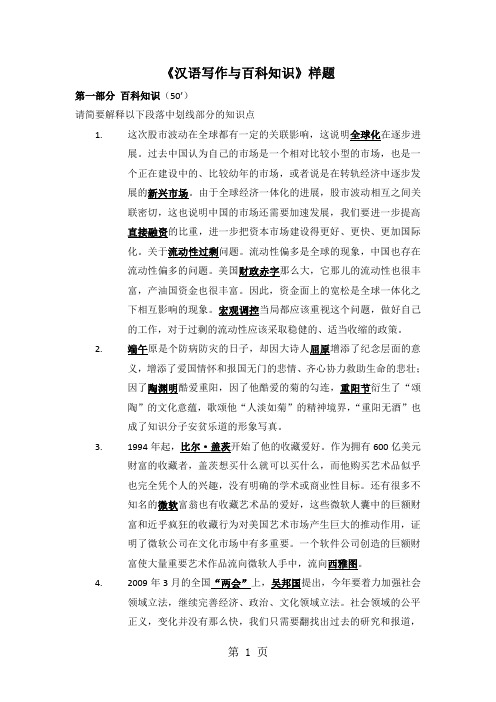
《汉语写作与百科知识》样题第一部分百科知识(50’)请简要解释以下段落中划线部分的知识点1.这次股市波动在全球都有一定的关联影响,这说明全球化在逐步进展。
过去中国认为自己的市场是一个相对比较小型的市场,也是一个正在建设中的、比较幼年的市场,或者说是在转轨经济中逐步发展的新兴市场。
由于全球经济一体化的进展,股市波动相互之间关联密切,这也说明中国的市场还需要加速发展,我们要进一步提高直接融资的比重,进一步把资本市场建设得更好、更快、更加国际化。
关于流动性过剩问题。
流动性偏多是全球的现象,中国也存在流动性偏多的问题。
美国财政赤字那么大,它那儿的流动性也很丰富,产油国资金也很丰富。
因此,资金面上的宽松是全球一体化之下相互影响的现象。
宏观调控当局都应该重视这个问题,做好自己的工作,对于过剩的流动性应该采取稳健的、适当收缩的政策。
2.端午原是个防病防灾的日子,却因大诗人屈原增添了纪念层面的意义,增添了爱国情怀和报国无门的悲情、齐心协力救助生命的悲壮;因了陶渊明酷爱重阳,因了他酷爱的菊的勾连,重阳节衍生了“颂陶”的文化意蕴,歌颂他“人淡如菊”的精神境界,“重阳无酒”也成了知识分子安贫乐道的形象写真。
3.1994年起,比尔·盖茨开始了他的收藏爱好。
作为拥有600亿美元财富的收藏者,盖茨想买什么就可以买什么,而他购买艺术品似乎也完全凭个人的兴趣,没有明确的学术或商业性目标。
还有很多不知名的微软富翁也有收藏艺术品的爱好,这些微软人囊中的巨额财富和近乎疯狂的收藏行为对美国艺术市场产生巨大的推动作用,证明了微软公司在文化市场中有多重要。
一个软件公司创造的巨额财富使大量重要艺术作品流向微软人手中,流向西雅图。
4.2009年3月的全国“两会”上,吴邦国提出,今年要着力加强社会领域立法,继续完善经济、政治、文化领域立法。
社会领域的公平正义,变化并没有那么快,我们只需要翻找出过去的研究和报道,就可以看到今天的问题所在。
翻译硕士考研2022川大外院《翻译硕士英语》考研真题
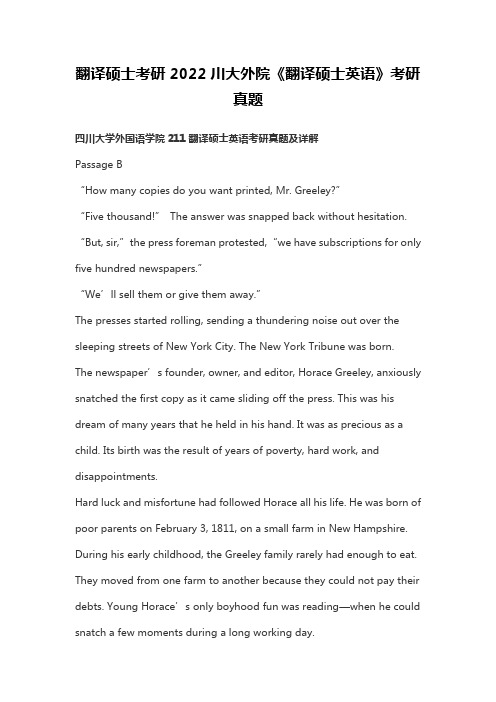
翻译硕士考研2022川大外院《翻译硕士英语》考研真题四川大学外国语学院211翻译硕士英语考研真题及详解Passage B“How many copies do you want printed, Mr. Greeley?”“Five thousand!”The answer was snapped back without hesitation. “But, sir,”the press foreman protested, “we have subscriptions for only five hundred newspapers.”“We’ll sell them or give them away.”The presses started rolling, sending a thundering noise out over the sleeping streets of New York City. The New York Tribune was born.The newspaper’s founder, owner, and editor, Horace Greeley, anxiously snatched the first copy as it came sliding off the press. This was his dream of many years that he held in his hand. It was as precious as a child. Its birth was the result of years of poverty, hard work, and disappointments.Hard luck and misfortune had followed Horace all his life. He was born of poor parents on February 3, 1811, on a small farm in New Hampshire. During his early childhood, the Greeley family rarely had enough to eat. They moved from one farm to another because they could not pay their debts. Young Horace’s only boyhood fun was reading—when he could snatch a few moments during a long working day.“The printed word always fascinated Horace. When he was only ten years old, he applied for a job as an apprentice in a printing shop. But he didn’t get the job because he was too young.Four years later, Horace walked eleven miles to East Poultney in Vermont to answer an ad. A paper called the Northern Spectator had a job for a boy. The editor asked him why he wanted to boa printer, Horace spoke up boldly: “Because, sir, I want to learn all I can about newspapers.”The editor looked at the oddly dressed boy. Finally he said, “You’ve got the job, son.”For the first six months, room and board would be the only pay for his work. After that, he would get room and board and forty dollars a year. Horace hurried home to shout the good news to his family. When he got there, he learned that his family was about to move again—this time to Pennsylvania. Horace decided to stay and work. Mrs. Greeley hated leaving her son behind, but gave her consent. Twice during his apprenticeship Horace walked six hundred miles to visit his family. Each time, he took all the money he had saved and gave it to his father.The Spectator failed after Horace had spent four years working for it. He joined his family in Erie, Pennsylvania, and got a job on the Erie Gazette. Half the money he earned he gave to his family. The other half he saved to go to New York.When he was twenty, Horace arrived in New York with ten dollars in his pocket. He was turned down twice when he asked for a job. Finally he became a typesetter for John T West’s Printery. The only reason Horace got the job was that it was so difficult other printers wouldn’t take it. His job was to set a very small edition of the Bible. Horace almost ruined his eyes at that job.As young Greeley’s skill grew, better jobs came his way. He could have bought better clothes and moved out of his dingy room. But he was used to being poor, and his habits did not change He spent practically nothing on himself. Even after his Tribune became a success, he lived as if he hadn’t enough money for his next meal.The Tribune grew and thrived. It was unlike any newspaper ever printed before in the United States. Greeley started a new type of journalism. His news stories were truthful and accurate His editorials attacked as well as praised. Many people disagreed with what he wrote, but still they read it. The Tribune became America’s first nationwide newspaper. It was read as eagerly in the Midwest and Far West as it was in the East. Greeley’s thundering editorials became the most powerful voice in the land. Greeley and his Tribune fought for many causes. He was the first to come out for the right of women to vote. His Tribune was the leader in demanding protection for homesteads in the West. He aroused the north in the fight against slavery. During a depression in the East, joblessmen asked what they could do to support themselves. Said Greeley: “Go West, young man, go West!”As the Tribune gained more power, Greeley became more interested in politics He led in forming and naming the Republican Party. He, more than any other man, was responsible for Abraham Lincoln’s being named to run for President.Horace Greeley was first of all a successful newspaperman. He was also a powerful political leader. But he was not a popular man. In 1872 he ran for President against Ulysses S Grant. Grant was re-elected by an overwhelming margin.Greeley was then in deep mourning over the recent death of his wife. He was heart-broken over losing the election. He never recovered from the double blow only weeks after his defeat, he died in New York City. His beloved Tribune lived on after him as the monument he wanted. Just before died, he wrote:“I cherish the hope that the journal I projected and established will live and flourish long after I shall have mouldered into forgotten dust, and that the stone that covers my ashes may bear to future eyes the still intelligible inscription, Founder of the New York Tribune.”6. Horace gladly accepted his first job ______.A. because of the kind of work it wasB. because of the high salary offeredC. because of the location of the officeD. became he couldn’t find any other job7. When Horace founded the Tribune he was ______.A. already a rich and famous newspapermanB. poor, but skilled in newspaper workC. poor, but eager to learn newspaper workD. rich and skilled in newspaper work8. The Tribune was different from all other American papers because it was ______.A. available by subscription onlyB. printed in New York cityC. distributed throughout the nationD. it offered the editor’s personal opinions only9. Before the Tribune was founded, news reporting was ______.A. honest but uninterestingB. distorted or dishonestC. almost unknownD. interesting but distorted10. Greeley probably felt that his greatest accomplishment was ______.A. rising from poverty to wealthB. becoming a popular political leaderC. founding the New York TribuneD. All of the above【答案与解析】6. A 句意:Horace很高兴地接受第一份工作的原因是这正是他想要的工作。
四川大学翻译硕士真题
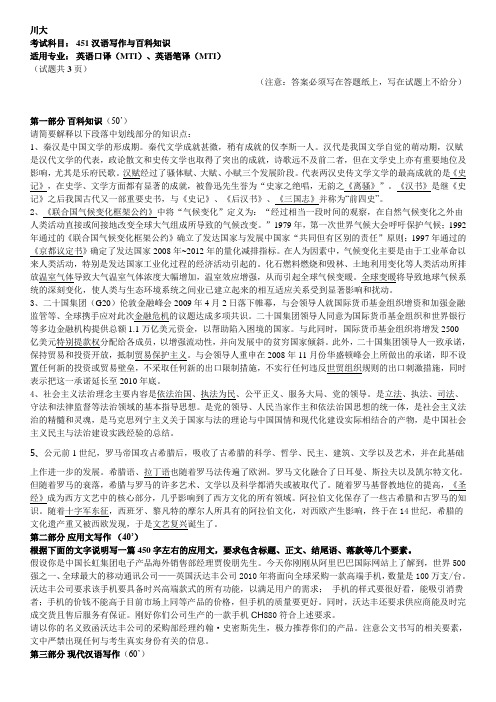
川大考试科目: 451汉语写作与百科知识适用专业:英语口译(MTI)、英语笔译(MTI)(试题共 3 页)(注意:答案必须写在答题纸上,写在试题上不给分)第一部分百科知识(50’)请简要解释以下段落中划线部分的知识点:1、秦汉是中国文学的形成期。
秦代文学成就甚微,稍有成就的仅李斯一人。
汉代是我国文学自觉的萌动期,汉赋是汉代文学的代表,政论散文和史传文学也取得了突出的成就,诗歌远不及前二者,但在文学史上亦有重要地位及影响,尤其是乐府民歌。
汉赋经过了骚体赋、大赋、小赋三个发展阶段。
代表两汉史传文学文学的最高成就的是《史记》,在史学、文学方面都有显著的成就,被鲁迅先生誉为“史家之绝唱,无韵之《离骚》”。
《汉书》是继《史记》之后我国古代又一部重要史书,与《史记》、《后汉书》、《三国志》并称为“前四史”。
2、《联合国气候变化框架公约》中将“气候变化”定义为:“经过相当一段时间的观察,在自然气候变化之外由人类活动直接或间接地改变全球大气组成所导致的气候改变。
”1979年,第一次世界气候大会呼吁保护气候;1992年通过的《联合国气候变化框架公约》确立了发达国家与发展中国家“共同但有区别的责任”原则;1997年通过的《京都议定书》确定了发达国家2008年~2012年的量化减排指标。
在人为因素中,气候变化主要是由于工业革命以来人类活动,特别是发达国家工业化过程的经济活动引起的。
化石燃料燃烧和毁林、土地利用变化等人类活动所排放温室气体导致大气温室气体浓度大幅增加,温室效应增强,从而引起全球气候变暖。
全球变暖将导致地球气候系统的深刻变化,使人类与生态环境系统之间业已建立起来的相互适应关系受到显著影响和扰动。
3、二十国集团(G20)伦敦金融峰会2009年4月2日落下帷幕,与会领导人就国际货币基金组织增资和加强金融监管等、全球携手应对此次金融危机的议题达成多项共识。
二十国集团领导人同意为国际货币基金组织和世界银行等多边金融机构提供总额1.1万亿美元资金,以帮助陷入困境的国家。
川大MTI参考书目

考试科目:
初试科目:政治理论、翻译硕士英语、英语翻译基础、汉语写作与百科知识,共计4门。
其中,政治理论为全国统考,翻译硕士英语、英语翻译基础、汉语写作与百科知识由我校自主命题。
复试科目:英语笔译:英语写作、面试;英语口译:英语写作、面试、听力。
均由我校自主命题。
六、参考书目
翻译硕士英语
《高级英语》》(修订本)第1、2册(重排版),张汉熙,外语教学与研究出版社,2010年。
英语翻译基础
1. 《英汉翻译简明教程》,庄绎传,外语教学与研究出版社,2002年;
2. 《英汉口译教程》,任文,外语教学与研究出版社,2011年
3. 《英语笔译实务》(三级)最新修订版,张春柏,外文出版社,2009年。
4. 《英语写作手册》(英文版)(第3版),丁往道、吴冰、钟美荪,外语教学与研究出版社,2009年
5. 国内主要英文报刊
汉语写作与百科知识
1. 《中国文化读本》(中文版)叶朗,外语教学与研究出版社,2008年
2. 《中国文化概要》,陶嘉炜、何寅,北京大学出版社,2009年
3. 《英语国家社会与文化》,梅仁毅,外语教学与研究出版社,2008年
4. 《应用文写作》,王首程,高等教育出版社,2009。
四川大学外国语学院全日制攻读翻译硕士专业学位研究生培养方案
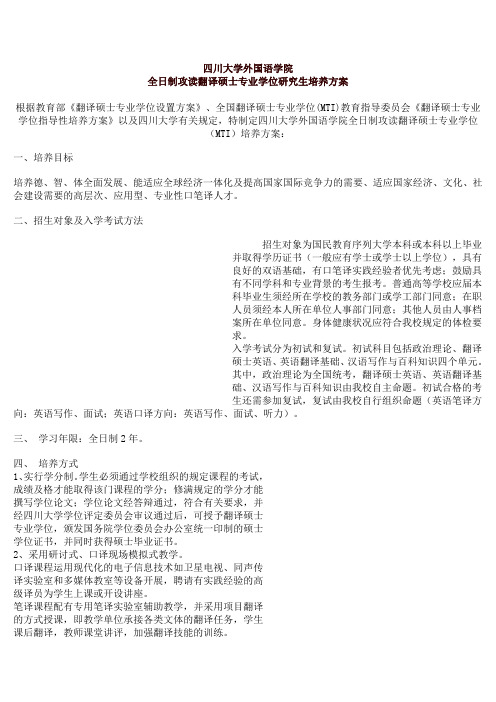
四川大学外国语学院全日制攻读翻译硕士专业学位研究生培养方案根据教育部《翻译硕士专业学位设置方案》、全国翻译硕士专业学位(MTI)教育指导委员会《翻译硕士专业学位指导性培养方案》以及四川大学有关规定,特制定四川大学外国语学院全日制攻读翻译硕士专业学位(MTI)培养方案:一、培养目标培养德、智、体全面发展、能适应全球经济一体化及提高国家国际竞争力的需要、适应国家经济、文化、社会建设需要的高层次、应用型、专业性口笔译人才。
二、招生对象及入学考试方法招生对象为国民教育序列大学本科或本科以上毕业并取得学历证书(一般应有学士或学士以上学位),具有良好的双语基础,有口笔译实践经验者优先考虑;鼓励具有不同学科和专业背景的考生报考。
普通高等学校应届本科毕业生须经所在学校的教务部门或学工部门同意;在职人员须经本人所在单位人事部门同意;其他人员由人事档案所在单位同意。
身体健康状况应符合我校规定的体检要求。
入学考试分为初试和复试。
初试科目包括政治理论、翻译硕士英语、英语翻译基础、汉语写作与百科知识四个单元。
其中,政治理论为全国统考,翻译硕士英语、英语翻译基础、汉语写作与百科知识由我校自主命题。
初试合格的考生还需参加复试,复试由我校自行组织命题(英语笔译方向:英语写作、面试;英语口译方向:英语写作、面试、听力)。
三、学习年限:全日制2年。
四、培养方式1、实行学分制。
学生必须通过学校组织的规定课程的考试,成绩及格才能取得该门课程的学分;修满规定的学分才能撰写学位论文;学位论文经答辩通过,符合有关要求,并经四川大学学位评定委员会审议通过后,可授予翻译硕士专业学位,颁发国务院学位委员会办公室统一印制的硕士学位证书,并同时获得硕士毕业证书。
2、采用研讨式、口译现场模拟式教学。
口译课程运用现代化的电子信息技术如卫星电视、同声传译实验室和多媒体教室等设备开展,聘请有实践经验的高级译员为学生上课或开设讲座。
笔译课程配有专用笔译实验室辅助教学,并采用项目翻译的方式授课,即教学单位承接各类文体的翻译任务,学生课后翻译,教师课堂讲评,加强翻译技能的训练。
川大MTI经验帖

走心的学姐,写川大经验MTI是每个学校自主命题,所以要考MTI,尽早决定自己要考哪所学校,到目标院校的官网去搜需要什么参考书,然后穷尽自己各种方式寻找信息。
因为考研不仅是学术能力的竞争过程,也是比拼搜商的过程。
当你经验贴看得够多了,也就知道了要准备哪些参考书,要练哪些翻译,也不会慌乱了。
每个人都是一步一步从考研小白到考研战士的。
一、基英背!单!词!!这是最基础也是最重要的。
背单词这个过程贯穿了我考研整个过程,当单词量真的上升到一定程度,你会发现自己英语像开挂了一样。
专八词汇,《李毅10000》,gre,一定要一个一个,一遍又一遍好好背。
背了一遍记不住没关系,再来一遍,我记得《李毅10000》我背了3遍还是4遍。
强烈推荐《英语文摘》这个杂志,它全是精选的外刊文章,翻译地道,而且有难点词语解释,是学习英语很好的材料。
建议每两天读一篇,一定要准备一个笔记本,把自己认为写得好的表达总结下来,不会的单词也摘抄下来,每天记,每天背单词。
然后就是完型。
完型可以买一本考研英语一的完型来练,感觉难度差不多,主要也是一个考词汇,文意理解的过程。
有一点要注意,它有可能会考同义词辨析,就比如让你区分finish和complete,这个在备考后期也需要掌握。
然后是阅读。
一般来说,要练阅读可以用专八阅读来练,但是自己对比你会发现专八的阅读都是从外刊上摘取的,外刊是针对时事,或评论或表达观点,语言通畅易懂,而川大的阅读涵盖非常广泛,哲学,文学,宗教,历史,都是出题范围,而且句子非常正式,表达的思想又很深刻,需要read beyond words,加大了阅读的难度,所以考川大的同学英语阅读功底不能差。
川大的参考书《高级英语》那两本可以当做阅读材料好好学习,提高自己的英语能力,这两本书里面文章的难度和基英阅读难度差不多,句子结构,表达方式都很像。
如果你读这两本书里的文章能读懂,那阅读也不用太担心了。
最后是作文。
川大的作文有点像专八,要阅读一段材料,再根据材料中内容写自己的观点,这就考察了阅读能力,总结归纳能力,论证观点能力。
- 1、下载文档前请自行甄别文档内容的完整性,平台不提供额外的编辑、内容补充、找答案等附加服务。
- 2、"仅部分预览"的文档,不可在线预览部分如存在完整性等问题,可反馈申请退款(可完整预览的文档不适用该条件!)。
- 3、如文档侵犯您的权益,请联系客服反馈,我们会尽快为您处理(人工客服工作时间:9:00-18:30)。
目录
一、2020 年翻译硕士 MTI 考研真题及考研笔记(2020 年考研状元整理)
二、2021 年翻译硕士 MTI 考研复习技巧及名师指导:词汇、翻译技巧、汉百与写作
三、2021 年全国 150 所翻译硕士 MTI 院校考研参考书、报名人数、复试线、报录比及参考书
具体内容
一、2020 年翻译硕士 MTI 考研真题及考研笔记
学术思想上的“左”右思潮及其对立历来存在,在一定范围、一定条件下还可能对立地比较严重,但无论何种 形式的对立,都不能将上“纲”上“线”,特别是不能单方面、人为地将其上升为某一指导性、强制性标准。不少 翻译工作者在谈到“简明英语”时,为了让别人坚信“简明”理念,往往说“简明英语”在整个西方都是通用标准, 如美国白宫、英国唐宁街等。但“简明英语”一则只是一种西方语言思潮,不可能成为所有人的代表及其语言使用 习惯;二则白宫、唐宁街等政府官方行为不能代表民间、公司等自然人、法人的行为。因此,上述论断本身存在逻 辑错误,而类似这样以偏概全的逻辑错误在我们不少高校翻译教学中仍然存在,对这类思潮所产生的消极影响不可 低估。
需要看到,一个译文的风格是否需要改变,要做多大程度的改变,不能完全取决于学术探讨或思潮,而应从实 际出发加以论证。十几年来,改革开放力度不断加大,中国人接触到了越来越多的西方思想,以至于部分人准备把 《政府工作报告》改造成西方的“国情咨文”,特别是摈弃那些官话、套话,开头不要“回顾五年工作”,结尾不要 “紧密团结”“努力奋斗”——这种迫切的改革思想,一方面反映出民众对“高效政府”的渴盼,另一方面反映出 对新思想、新模式的尝试热情。但这几年我们围绕《报告》英译文的诸多探讨,有些已经明显超出了必要的限度, 主张将“简明英语”从学术探讨上升为具体操作,甚至上升为强制性标准。部分翻译教师在教学过程中,将“简明 英语”的部分标准绝对化、神圣化,凡是与这些标准不同的,就被判定为“不简明”或“中式英语”,这些判断显 然有失学术公允,日益走向了学术霸权甚至政治化的极端。这一点务必引起广大翻译教师、翻译工作者的警惕。
2020 年四川大学翻译硕士 MTI 考研真题及考研参考书
育明教育 506 大印老师 联合各大翻硕名校导师及考研状元联合整理 2019 年 9 月 10 日星期日
【温馨解析】翻译硕士 MTI 专业,是一个比较适合于非英语专业学生报考的研究生考研专业,尤其是对于非英语 专业的考生而言,一定要把握住汉语写作与百科知识(参考《汉语写作与百科知识》,首都师范大学出版社,2019 年版)以及政治这两门课,因为这是加分项,是可以凸显优势的两门课所以,一定要重视。此外,每个院校考察的 汉语写作与百科知识的侧重点是不同的,比如北大侧重中国古代文学及历史,北外侧重考察时政热点。而且从翻译 硕士英语和英语翻译基础而言,考察的也不同(参考《翻译硕士 MTI 常考词汇》,首都师范大学出版社,2020 年版; 《翻译硕士考研真题解析》,首都师范大学出版社,2020 年版)。比如,北大侧重于现当代文学的翻译,北二外侧重 经济管理类的翻译等。
作为非英语母语国家,我们对英语的认知和研究不可避免要与汉语发生关联,而英汉语言对比的正确前提是尊 重差异,特别是尊重文化和社会差异。比如不少人说:英语尽可能回避重复,而汉语则以重复作为一种修辞手段, 这种观点不太准确,原因有二:一是英语是否回避重复,主要看文体和需要;二是汉语修辞是否已重复为上策没有 定论。这些问题我们还将在后续章节加以分析。
育明考研考博培训中心官网:
多有意向报考翻译硕士的考生来说,尤其是跨专业的考生,在备考过程中应该具备怎样的水平,在考前应该达到什
因此,是否通过 CATTI,是否需要参加 CATTI,不能也不应该作为是否能够通向与指导意义上的不同,从而更好地选择自己的道路。
二、2021 年翻译硕士 MTI 考研复习技巧及名师指导:词汇、翻译技巧、汉百与写作
根据育明教育高级咨询师大印老师(微信 15311220200)近 10 年翻译硕士研究,翻译硕士是比较适合跨专业 报考的,对于跨专业的考生来讲,最重要的就是要把握好政治和汉语写作与百科知识,这是拿分点。此外,对于很
育明考研考博培训中心官网:
籍并未涉及此点),慢慢地,《报告》就成了“简明英语”的最佳代表。从学术研究的角度看无可厚非,说明《报告》 英译文可能需要进一步完善,但从翻译教学和市场运作看,就成了对《报告》及其代表的传统政府文件翻译的公开 批判。更关键的是,部分翻译人士在这一过程中看到“简明英语”的品牌和商用价值,于是纷纷用“简明英语”包 装自己,并用这种方式与《报告》划清界限。现在,我们只要问问高校教师和学生“你对《报告》英译文是什么态 度”就不难得出这所院校的翻译教学思路了。
